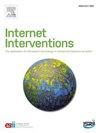How do we know that they actually use it? Exploring measures of adherence to stress management strategies in university students: A systematic review
IF 4.1
2区 医学
Q1 HEALTH CARE SCIENCES & SERVICES
Internet Interventions-The Application of Information Technology in Mental and Behavioural Health
Pub Date : 2025-08-12
DOI:10.1016/j.invent.2025.100868
引用次数: 0
Abstract
University students are reporting high levels of stress that interfere with their academic performance and daily functioning. In response, higher education institutions have increasingly implemented digital, self-guided stress management resources to provide students with accessible mental health support. While these interventions show promise for improving student wellness, there is a significant gap in our understanding of how students use the strategies taught as part of these resources. This systematic review therefore examined if and how adherence (i.e., strategy use) has been measured in the context of digital self-guided stress management interventions, as well as its associations with stress and other wellness outcomes. Of the 40 studies that met eligibility criteria for the present review, 33 measured adherence (82.5 %). Specifically, nine studies measured frequency (27.2 %), eight measured completion rates (24.2 %), two measured duration (6.1 %), 12 used a combination of these approaches (36.4 %), and two (6.1 %) did not specify which approach was used. Surprisingly, although the majority of studies collected data on adherence, the associations between adherence and stress or other wellness outcomes were scarcely examined. Across studies, adherence was measured using digital analytics and/or self-report; however, barriers were identified in using these methods, including technological issues and challenges in measurement accuracy. Quality assessments revealed a moderate risk of bias. Future research should explore different approaches to enhance adherence measurement accuracy and further examine the link between adherence and wellness outcomes to determine the optimal dose of strategy use for enhancing wellness among university students.
我们怎么知道他们真的在使用它呢?探索大学生压力管理策略依从性的措施:系统回顾
据报道,大学生的压力水平很高,影响了他们的学习成绩和日常生活。作为回应,高等教育机构越来越多地实施数字化、自我指导的压力管理资源,为学生提供可获得的心理健康支持。虽然这些干预措施显示出改善学生健康的希望,但我们对学生如何使用作为这些资源一部分的教学策略的理解存在重大差距。因此,本系统综述检查了在数字自我指导压力管理干预措施的背景下,是否以及如何衡量依从性(即策略使用),以及它与压力和其他健康结果的关联。在符合本综述资格标准的40项研究中,33项测量了依从性(82.5%)。具体来说,9项研究测量了频率(27.2%),8项研究测量了完成率(24.2%),2项研究测量了持续时间(6.1%),12项研究使用了这些方法的组合(36.4%),2项研究(6.1%)没有指定使用哪种方法。令人惊讶的是,尽管大多数研究收集了关于坚持的数据,但坚持与压力或其他健康结果之间的关系几乎没有得到检验。在所有研究中,使用数字分析和/或自我报告来衡量依从性;然而,在使用这些方法时发现了障碍,包括技术问题和测量精度方面的挑战。质量评估显示有中等偏倚风险。未来的研究应该探索不同的方法来提高依从性测量的准确性,并进一步研究依从性与健康结果之间的联系,以确定使用策略的最佳剂量来增强大学生的健康。
本文章由计算机程序翻译,如有差异,请以英文原文为准。
求助全文
约1分钟内获得全文
求助全文
来源期刊

Internet Interventions-The Application of Information Technology in Mental and Behavioural Health
Medicine-Health Informatics
CiteScore
6.50
自引率
9.30%
发文量
94
审稿时长
6 weeks
期刊介绍:
Official Journal of the European Society for Research on Internet Interventions (ESRII) and the International Society for Research on Internet Interventions (ISRII).
The aim of Internet Interventions is to publish scientific, peer-reviewed, high-impact research on Internet interventions and related areas.
Internet Interventions welcomes papers on the following subjects:
• Intervention studies targeting the promotion of mental health and featuring the Internet and/or technologies using the Internet as an underlying technology, e.g. computers, smartphone devices, tablets, sensors
• Implementation and dissemination of Internet interventions
• Integration of Internet interventions into existing systems of care
• Descriptions of development and deployment infrastructures
• Internet intervention methodology and theory papers
• Internet-based epidemiology
• Descriptions of new Internet-based technologies and experiments with clinical applications
• Economics of internet interventions (cost-effectiveness)
• Health care policy and Internet interventions
• The role of culture in Internet intervention
• Internet psychometrics
• Ethical issues pertaining to Internet interventions and measurements
• Human-computer interaction and usability research with clinical implications
• Systematic reviews and meta-analysis on Internet interventions
 求助内容:
求助内容: 应助结果提醒方式:
应助结果提醒方式:


